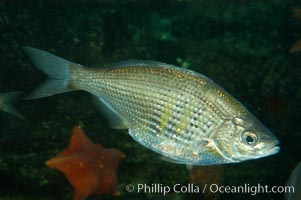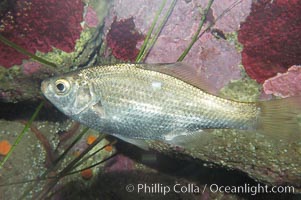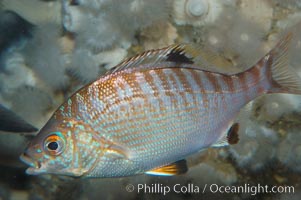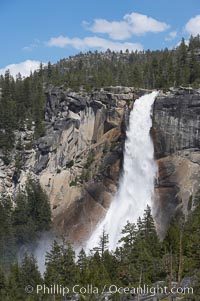
Nevada Falls marks where the Merced River plummets almost 600 through a joint in the Little Yosemite Valley, shooting out from a sheer granite cliff and then down to a boulder pile far below.
Location: Nevada Falls, Yosemite National Park, California
Image ID: 16114
Location: Nevada Falls, Yosemite National Park, California
Image ID: 16114
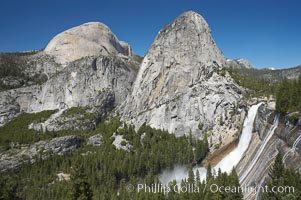
Nevada Falls, with Liberty Cap (center) and Half Dome (left). Nevada Falls marks where the Merced River plummets almost 600 feet through a joint in the Little Yosemite Valley, shooting out from a sheer granite cliff and then down to a boulder pile far below.
Location: Nevada Falls, Yosemite National Park, California
Image ID: 16115
Location: Nevada Falls, Yosemite National Park, California
Image ID: 16115
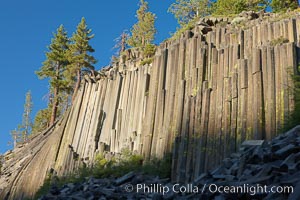
Devil's Postpile, a spectacular example of columnar basalt. Once molten and under great pressure underground, the lava that makes up Devil's Postpile cooled evenly and slowly, contracting and fracturing into polygonal-sided columns. The age of the formation is estimated between 100 and 700 thousand years old. Sometime after the basalt columns formed, a glacier passed over the formation, cutting and polishing the tops of the columns. The columns have from three to seven sides, varying because of differences in how quickly portions of the lava cooled.
Location: Devils Postpile National Monument, California
Image ID: 23266
Location: Devils Postpile National Monument, California
Image ID: 23266
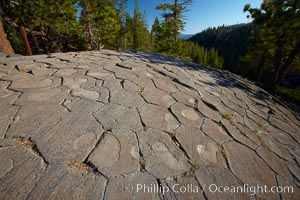
Devil's Postpile, a spectacular example of columnar basalt. Once molten and under great pressure underground, the lava that makes up Devil's Postpile cooled evenly and slowly, contracting and fracturing into polygonal-sided columns. The age of the formation is estimated between 100 and 700 thousand years old. Sometime after the basalt columns formed, a glacier passed over the formation, cutting and polishing the tops of the columns. The columns have from three to seven sides, varying because of differences in how quickly portions of the lava cooled.
Location: Devils Postpile National Monument, California
Image ID: 23267
Location: Devils Postpile National Monument, California
Image ID: 23267
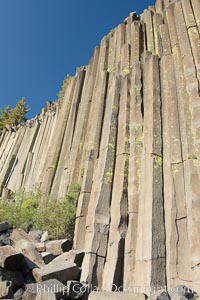
Devil's Postpile, a spectacular example of columnar basalt. Once molten and under great pressure underground, the lava that makes up Devil's Postpile cooled evenly and slowly, contracting and fracturing into polygonal-sided columns. The age of the formation is estimated between 100 and 700 thousand years old. Sometime after the basalt columns formed, a glacier passed over the formation, cutting and polishing the tops of the columns. The columns have from three to seven sides, varying because of differences in how quickly portions of the lava cooled.
Location: Devils Postpile National Monument, California
Image ID: 23285
Location: Devils Postpile National Monument, California
Image ID: 23285
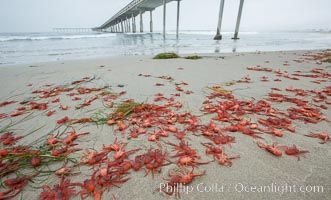
Pelagic red tuna crabs, washed ashore to form dense piles on the beach.
Species: Pelagic red crab, Pleuroncodes planipes
Location: Ocean Beach, California
Image ID: 30982
Species: Pelagic red crab, Pleuroncodes planipes
Location: Ocean Beach, California
Image ID: 30982
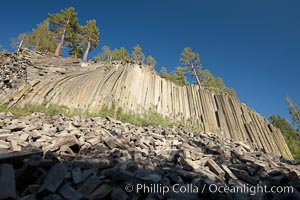
Devil's Postpile, a spectacular example of columnar basalt. Once molten and under great pressure underground, the lava that makes up Devil's Postpile cooled evenly and slowly, contracting and fracturing into polygonal-sided columns. The age of the formation is estimated between 100 and 700 thousand years old. Sometime after the basalt columns formed, a glacier passed over the formation, cutting and polishing the tops of the columns. The columns have from three to seven sides, varying because of differences in how quickly portions of the lava cooled.
Location: Devils Postpile National Monument, California
Image ID: 23281
Location: Devils Postpile National Monument, California
Image ID: 23281
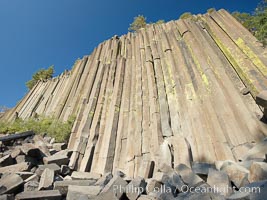
Devil's Postpile, a spectacular example of columnar basalt. Once molten and under great pressure underground, the lava that makes up Devil's Postpile cooled evenly and slowly, contracting and fracturing into polygonal-sided columns. The age of the formation is estimated between 100 and 700 thousand years old. Sometime after the basalt columns formed, a glacier passed over the formation, cutting and polishing the tops of the columns. The columns have from three to seven sides, varying because of differences in how quickly portions of the lava cooled.
Location: Devils Postpile National Monument, California
Image ID: 23282
Location: Devils Postpile National Monument, California
Image ID: 23282
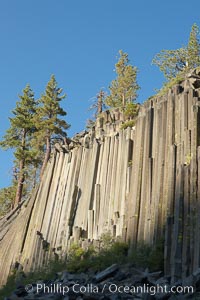
Devil's Postpile, a spectacular example of columnar basalt. Once molten and under great pressure underground, the lava that makes up Devil's Postpile cooled evenly and slowly, contracting and fracturing into polygonal-sided columns. The age of the formation is estimated between 100 and 700 thousand years old. Sometime after the basalt columns formed, a glacier passed over the formation, cutting and polishing the tops of the columns. The columns have from three to seven sides, varying because of differences in how quickly portions of the lava cooled.
Location: Devils Postpile National Monument, California
Image ID: 23283
Location: Devils Postpile National Monument, California
Image ID: 23283
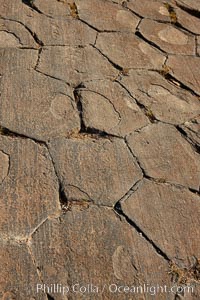
Devil's Postpile, a spectacular example of columnar basalt. Once molten and under great pressure underground, the lava that makes up Devil's Postpile cooled evenly and slowly, contracting and fracturing into polygonal-sided columns. The age of the formation is estimated between 100 and 700 thousand years old. Sometime after the basalt columns formed, a glacier passed over the formation, cutting and polishing the tops of the columns. The columns have from three to seven sides, varying because of differences in how quickly portions of the lava cooled.
Location: Devils Postpile National Monument, California
Image ID: 23284
Location: Devils Postpile National Monument, California
Image ID: 23284
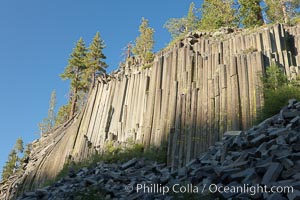
Devil's Postpile, a spectacular example of columnar basalt. Once molten and under great pressure underground, the lava that makes up Devil's Postpile cooled evenly and slowly, contracting and fracturing into polygonal-sided columns. The age of the formation is estimated between 100 and 700 thousand years old. Sometime after the basalt columns formed, a glacier passed over the formation, cutting and polishing the tops of the columns. The columns have from three to seven sides, varying because of differences in how quickly portions of the lava cooled.
Location: Devils Postpile National Monument, California
Image ID: 23286
Location: Devils Postpile National Monument, California
Image ID: 23286
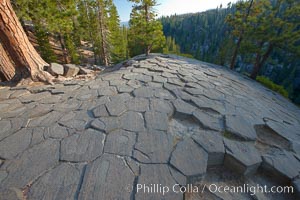
Devil's Postpile, a spectacular example of columnar basalt. Once molten and under great pressure underground, the lava that makes up Devil's Postpile cooled evenly and slowly, contracting and fracturing into polygonal-sided columns. The age of the formation is estimated between 100 and 700 thousand years old. Sometime after the basalt columns formed, a glacier passed over the formation, cutting and polishing the tops of the columns. The columns have from three to seven sides, varying because of differences in how quickly portions of the lava cooled.
Location: Devils Postpile National Monument, California
Image ID: 23287
Location: Devils Postpile National Monument, California
Image ID: 23287
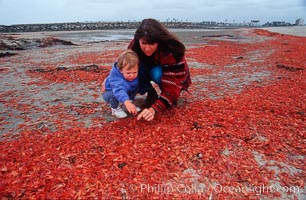
Pelagic red tuna crabs, washed ashore to form dense piles on the beach.
Species: Pelagic red crab, Pleuroncodes planipes
Location: Ocean Beach, California
Image ID: 06068
Species: Pelagic red crab, Pleuroncodes planipes
Location: Ocean Beach, California
Image ID: 06068
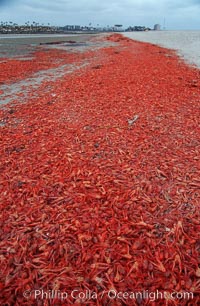
Pelagic red tuna crabs, washed ashore to form dense piles on the beach.
Species: Pelagic red crab, Pleuroncodes planipes
Location: Ocean Beach, California
Image ID: 06077
Species: Pelagic red crab, Pleuroncodes planipes
Location: Ocean Beach, California
Image ID: 06077
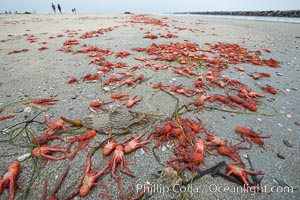
Pelagic red tuna crabs, washed ashore to form dense piles on the beach.
Species: Pelagic red crab, Pleuroncodes planipes
Location: Ocean Beach, California
Image ID: 30980
Species: Pelagic red crab, Pleuroncodes planipes
Location: Ocean Beach, California
Image ID: 30980
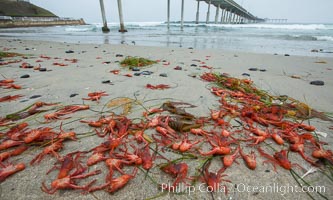
Pelagic red tuna crabs, washed ashore to form dense piles on the beach.
Species: Pelagic red crab, Pleuroncodes planipes
Location: Ocean Beach, California
Image ID: 30981
Species: Pelagic red crab, Pleuroncodes planipes
Location: Ocean Beach, California
Image ID: 30981
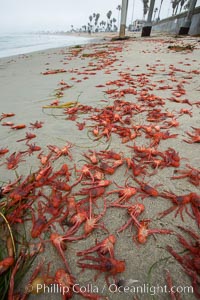
Pelagic red tuna crabs, washed ashore to form dense piles on the beach.
Species: Pelagic red crab, Pleuroncodes planipes
Location: Ocean Beach, California
Image ID: 30983
Species: Pelagic red crab, Pleuroncodes planipes
Location: Ocean Beach, California
Image ID: 30983

Lyretail fairy basslet, male.
Species: Jewel fairy basslet, Pseudanthias squamipinnis
Image ID: 12866
Species: Jewel fairy basslet, Pseudanthias squamipinnis
Image ID: 12866

Lyretail fairy basslet, female.
Species: Jewel fairy basslet, Pseudanthias squamipinnis
Image ID: 11795
Species: Jewel fairy basslet, Pseudanthias squamipinnis
Image ID: 11795

Lyretail fairy basslet, female.
Species: Jewel fairy basslet, Pseudanthias squamipinnis
Image ID: 11796
Species: Jewel fairy basslet, Pseudanthias squamipinnis
Image ID: 11796
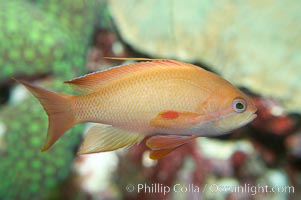
Lyretail fairy basslet, female.
Species: Jewel fairy basslet, Pseudanthias squamipinnis
Image ID: 11797
Species: Jewel fairy basslet, Pseudanthias squamipinnis
Image ID: 11797

Lyretail fairy basslet, female.
Species: Jewel fairy basslet, Pseudanthias squamipinnis
Image ID: 11798
Species: Jewel fairy basslet, Pseudanthias squamipinnis
Image ID: 11798

Lyretail fairy basslet, female.
Species: Jewel fairy basslet, Pseudanthias squamipinnis
Image ID: 11799
Species: Jewel fairy basslet, Pseudanthias squamipinnis
Image ID: 11799
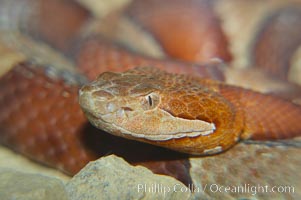
Trans-Pecos copperhead snake. The Trans-Pecos copperhead is a pit viper found in the Chihuahuan desert of west Texas. It is found near streams and rivers, wooded areas, logs and woodpiles.
Species: Trans-pecos copperhead snake, Agkistrodon contortrix pictigaster
Image ID: 12578
Species: Trans-pecos copperhead snake, Agkistrodon contortrix pictigaster
Image ID: 12578
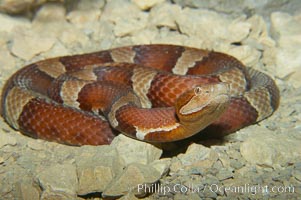
Trans-Pecos copperhead snake. The Trans-Pecos copperhead is a pit viper found in the Chihuahuan desert of west Texas. It is found near streams and rivers, wooded areas, logs and woodpiles.
Species: Trans-pecos copperhead snake, Agkistrodon contortrix pictigaster
Image ID: 12579
Species: Trans-pecos copperhead snake, Agkistrodon contortrix pictigaster
Image ID: 12579
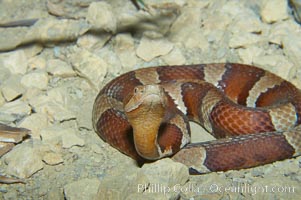
Trans-Pecos copperhead snake. The Trans-Pecos copperhead is a pit viper found in the Chihuahuan desert of west Texas. It is found near streams and rivers, wooded areas, logs and woodpiles.
Species: Trans-pecos copperhead snake, Agkistrodon contortrix pictigaster
Image ID: 12580
Species: Trans-pecos copperhead snake, Agkistrodon contortrix pictigaster
Image ID: 12580
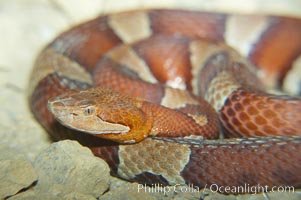
Trans-Pecos copperhead snake. The Trans-Pecos copperhead is a pit viper found in the Chihuahuan desert of west Texas. It is found near streams and rivers, wooded areas, logs and woodpiles.
Species: Trans-pecos copperhead snake, Agkistrodon contortrix pictigaster
Image ID: 12581
Species: Trans-pecos copperhead snake, Agkistrodon contortrix pictigaster
Image ID: 12581
